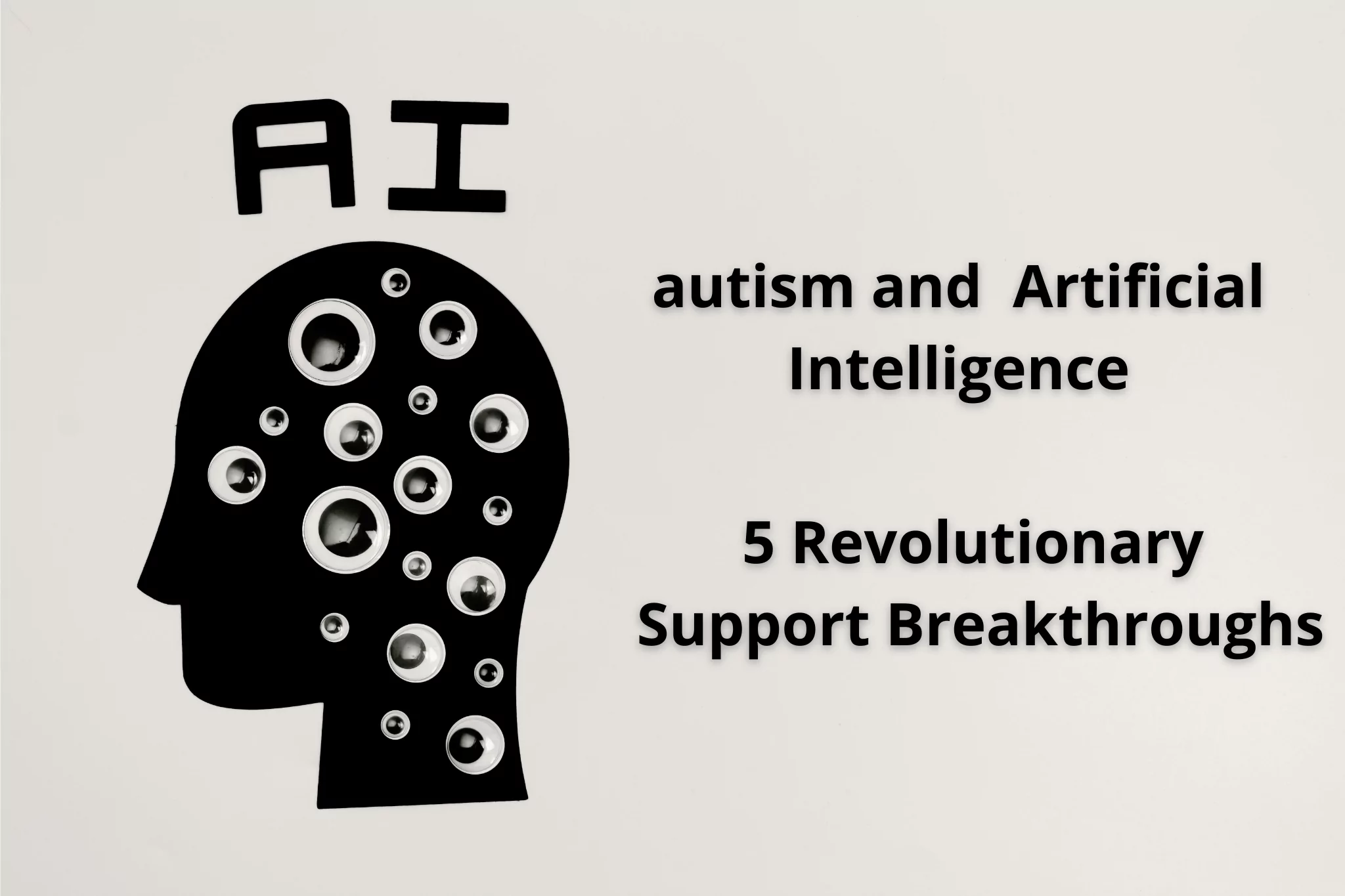With 9 years of experience in the kitchen, I’m passionate about crafting delicious recipes and sharing them with food lovers worldwide. 🍽️✨ Whether it’s a comforting homemade dish or a creative cocktail, my goal is to make cooking fun, easy, and enjoyable for everyone. Join me on this flavorful journey! 🍹🥗

Autism and Artificial Intelligence: 5 Revolutionary Support Breakthroughs
The Ultimate Guide to Autism and AI Innovations
Introduction to Autism and AI
The intersection of autism and Artificial Intelligence (AI) represents a paradigm shift in how we understand, support, and empower individuals on the autism spectrum. For years, traditional methods have been the cornerstone of autism support, but the advent of AI offers innovative and potentially transformative solutions. This guide explores the groundbreaking ways AI is revolutionizing autism support, providing a comprehensive overview of its benefits, implementation strategies, and future potential. We’ll delve into specific AI-powered tools and techniques that are already making a significant difference in communication, therapy, education, and daily living for individuals with autism. By understanding and harnessing the power of AI, we can create more inclusive, personalized, and effective support systems that help individuals with autism thrive.
This comprehensive exploration aims to provide a detailed understanding of how AI is converging with autism support to create a more supportive and inclusive environment. From personalized learning programs to advanced communication tools, the possibilities are vast and constantly evolving. Join us as we uncover the revolutionary potential of AI in shaping a brighter future for the autism community. Learn more about us and our commitment to innovation.
What Is Autism and AI?
To understand the transformative potential of their combination, it’s crucial to define both autism and Artificial Intelligence individually. Autism Spectrum Disorder (ASD) is a complex neurodevelopmental condition characterized by persistent deficits in social communication and social interaction across multiple contexts. These deficits can include difficulties with reciprocal social interaction, nonverbal communication, and developing and maintaining relationships. ASD also often involves restricted, repetitive patterns of behavior, interests, or activities. It’s a spectrum disorder, meaning that individuals experience a wide range of symptoms and severity levels. Diagnostic criteria for ASD are outlined in the Diagnostic and Statistical Manual of Mental Disorders (DSM-5).
Artificial Intelligence (AI), on the other hand, is a broad field of computer science focused on creating machines that can perform tasks that typically require human intelligence. This includes learning, problem-solving, decision-making, speech recognition, and visual perception. AI encompasses various subfields, such as machine learning, natural language processing (NLP), and computer vision. Machine learning algorithms allow AI systems to learn from data without being explicitly programmed, while NLP enables computers to understand and process human language. Computer vision enables AI systems to “see” and interpret images and videos.
Core Principles of AI in Autism Support
The power of combining AI with autism support lies in applying AI’s capabilities to address the core challenges faced by individuals with ASD. This involves several core principles:
- Personalization: AI can analyze individual data to create customized interventions and support systems tailored to specific needs and strengths.
- Data-Driven Insights: AI algorithms can analyze large datasets to identify patterns and trends that can inform diagnosis, treatment, and research.
- Accessibility: AI-powered tools can make communication and learning more accessible for individuals with communication difficulties.
- Automation: AI can automate repetitive tasks, freeing up therapists and caregivers to focus on more complex and nuanced interactions.
- Objectivity: AI can provide objective assessments and feedback, reducing bias and improving the accuracy of evaluations.
These core principles drive the development of innovative AI solutions that are transforming the landscape of autism support. Consider exploring our services to see how we apply these principles.
AI vs. Alternative Approaches
Traditional approaches to autism support, such as Applied Behavior Analysis (ABA) and speech therapy, have proven effective for many individuals. However, these approaches can be resource-intensive, time-consuming, and may not always be accessible to everyone. Furthermore, they often rely on standardized protocols that may not be fully tailored to the unique needs of each individual.
AI offers several advantages over these traditional approaches. AI-powered tools can provide personalized interventions at scale, making support more accessible and affordable. They can also analyze data in real-time to provide immediate feedback and adjust interventions as needed. Additionally, AI can automate repetitive tasks, freeing up therapists and caregivers to focus on more complex aspects of support. While AI is not intended to replace traditional approaches entirely, it can serve as a valuable complement, enhancing their effectiveness and reach.
Key Benefits of AI in Autism Support
The integration of AI brings numerous benefits to individuals with ASD, their families, and the professionals who support them. These benefits span various domains, including communication, therapy, education, and daily living.
Efficiency Improvements with AI
AI algorithms can automate tasks that are typically time-consuming for therapists and educators. For example, AI-powered tools can analyze speech patterns to identify areas where individuals with autism may be struggling with communication. They can also generate personalized learning materials based on individual learning styles and preferences. This automation frees up professionals to focus on more complex and nuanced aspects of support, such as building rapport and providing emotional support. Furthermore, AI can provide real-time feedback on interventions, allowing for immediate adjustments and improved outcomes. You can contact us to learn more about our commitment to improving efficiency.
Cost-Reduction Advantages of AI
Traditional autism support services can be expensive, making them inaccessible to many families. AI-powered tools have the potential to significantly reduce the cost of support by automating tasks, providing remote access to interventions, and reducing the need for in-person therapy sessions. For example, AI-powered communication apps can help individuals with autism improve their communication skills at home, reducing the need for frequent speech therapy sessions. Additionally, AI can personalize learning materials, reducing the need for expensive specialized tutoring.
These cost-reduction advantages make autism support more accessible to a wider range of individuals and families, promoting equity and inclusivity. The accessibility benefits also extend to remote areas and underserved communities, enabling access to quality support irrespective of geographical location or socioeconomic status. For example, platforms leveraging AI can deliver remote therapy, virtual social skills training, and personalized educational content to individuals living in areas where specialized services are scarce.
Implementing AI Solutions Successfully
Successful implementation of AI requires careful planning, consideration of ethical implications, and a focus on individual needs. It’s essential to understand the technical aspects of AI tools and how to integrate them into existing support systems effectively.
Step-by-Step AI Setup Guide
- Assess Individual Needs: Begin by conducting a thorough assessment of the individual’s strengths, challenges, and goals. This will help identify the specific areas where AI can be most beneficial.
- Select Appropriate AI Tools: Research and evaluate different AI-powered tools that are relevant to the individual’s needs. Consider factors such as ease of use, cost, and evidence-based effectiveness.
- Train Users: Provide training to individuals with autism, their families, and professionals on how to use the AI tools effectively. Ensure that users understand the purpose of the tools and how to interpret the results.
- Integrate into Existing Support Systems: Integrate AI tools into existing therapy, education, and support systems. This ensures that AI is used as a complement to, rather than a replacement for, traditional approaches.
- Monitor Progress: Regularly monitor the individual’s progress and adjust the AI tools and interventions as needed. Collect data to track outcomes and identify areas for improvement.
- Address Ethical Considerations: Consider the ethical implications of using AI, such as data privacy, algorithmic bias, and the potential for over-reliance on technology. Ensure that AI is used in a responsible and ethical manner.
AI Integration Strategies
Successful integration of AI requires a holistic approach that considers the individual’s entire support network. Here are some strategies for effective integration:
- Collaboration: Foster collaboration between therapists, educators, families, and AI developers. This ensures that AI tools are aligned with the individual’s needs and goals.
- Personalization: Customize AI tools to meet the individual’s specific needs and preferences. This ensures that the tools are engaging and effective.
- Flexibility: Allow for flexibility in how AI tools are used. This ensures that the tools can be adapted to changing needs and circumstances.
- Ongoing Support: Provide ongoing support to individuals, families, and professionals as they use AI tools. This ensures that they have the resources they need to use the tools effectively.
Advanced AI Techniques for Autism
As the field of AI evolves, advanced techniques are emerging that offer even greater potential for transforming support systems. These techniques leverage the latest advances in machine learning, NLP, and computer vision to address complex challenges and unlock new possibilities.
Optimizing AI Performance
Optimizing the performance of AI-powered tools requires a data-driven approach that focuses on continuous improvement. This involves collecting data on how the tools are being used, analyzing the data to identify areas for improvement, and making adjustments to the tools accordingly. Here are some techniques for optimizing AI performance:
- Data Collection: Collect data on user interactions, outcomes, and feedback.
- Data Analysis: Analyze the data to identify patterns and trends.
- A/B Testing: Conduct A/B tests to compare different versions of AI tools.
- User Feedback: Solicit feedback from users to identify areas for improvement.
AI Customization Options
Customization is a key factor in the success of AI. By customizing AI tools to meet the individual’s specific needs and preferences, we can ensure that they are engaging, effective, and aligned with their goals. Here are some customization options:
- Personalized Content: Customize the content of AI tools to match the individual’s interests and learning style.
- Adaptive Difficulty Levels: Adjust the difficulty level of AI tasks to match the individual’s skill level.
- User Interface Customization: Customize the user interface of AI tools to make them more accessible and user-friendly.
- Feedback Customization: Customize the feedback provided by AI tools to be more motivating and supportive.
Common Challenges in AI Integration
While the potential of AI is immense, there are also challenges to overcome. These challenges include technical limitations, ethical considerations, and implementation barriers.
Troubleshooting AI Issues
When implementing AI-powered tools, it’s essential to have a plan for troubleshooting common issues. This includes addressing technical glitches, user errors, and unexpected outcomes. Here are some tips for troubleshooting AI issues:
- Identify the Problem: Clearly define the issue that is occurring.
- Gather Information: Collect data on the context in which the issue occurred.
- Test Solutions: Try different solutions to see if they resolve the issue.
- Seek Support: Consult with AI developers or technical experts for assistance.
AI Maintenance Best Practices
Maintaining AI-powered tools is essential for ensuring their long-term effectiveness. This involves regularly updating software, monitoring performance, and addressing any issues that arise. Here are some best practices for AI maintenance:
- Software Updates: Install software updates regularly to ensure that AI tools are running smoothly and securely.
- Performance Monitoring: Monitor the performance of AI tools to identify any issues or areas for improvement.
- Data Backup: Back up data regularly to prevent data loss.
- Security Measures: Implement security measures to protect data from unauthorized access.
Future Trends in AI and Autism
The future of AI is bright, with ongoing research and development pushing the boundaries of what’s possible. Several key trends are shaping the future of this field:
- Personalized Medicine: AI will play an increasingly important role in personalized medicine, tailoring treatments to the individual’s unique genetic makeup and characteristics.
- Early Detection: AI will be used to develop tools for early detection of autism, allowing for earlier intervention and improved outcomes.
- Robotics: Robots will be used to provide social interaction and support to individuals with autism.
- Virtual Reality: Virtual reality will be used to create immersive learning experiences for individuals with autism.
These future trends promise to revolutionize autism support, making it more effective, accessible, and personalized. As AI technology continues to advance, we can expect even more innovative solutions to emerge, transforming the lives of individuals with autism and their families. Consider exploring resources available on sites like Wikipedia to further your understanding.
Conclusion: Mastering AI for Autism
The convergence of AI with autism support represents a significant leap forward in the way we understand and support individuals on the autism spectrum. By harnessing the power of AI, we can create more personalized, efficient, and accessible support systems that empower individuals with autism to thrive. While challenges remain, the potential benefits of AI in autism support are undeniable. From improving communication and social skills to enhancing learning and daily living, AI is transforming lives and shaping a brighter future for the autism community. Embracing this technology responsibly and ethically is crucial to maximizing its positive impact.
FAQ
- What is the primary benefit of AI in autism support?
The primary benefit is the ability to create highly personalized and efficient support systems tailored to the unique needs of individuals with autism, improving communication, learning, and daily living skills. - How long does AI implementation take?
Implementation time varies depending on the specific AI tools and individual needs. It can range from a few weeks to several months, including assessment, setup, training, and ongoing monitoring.




